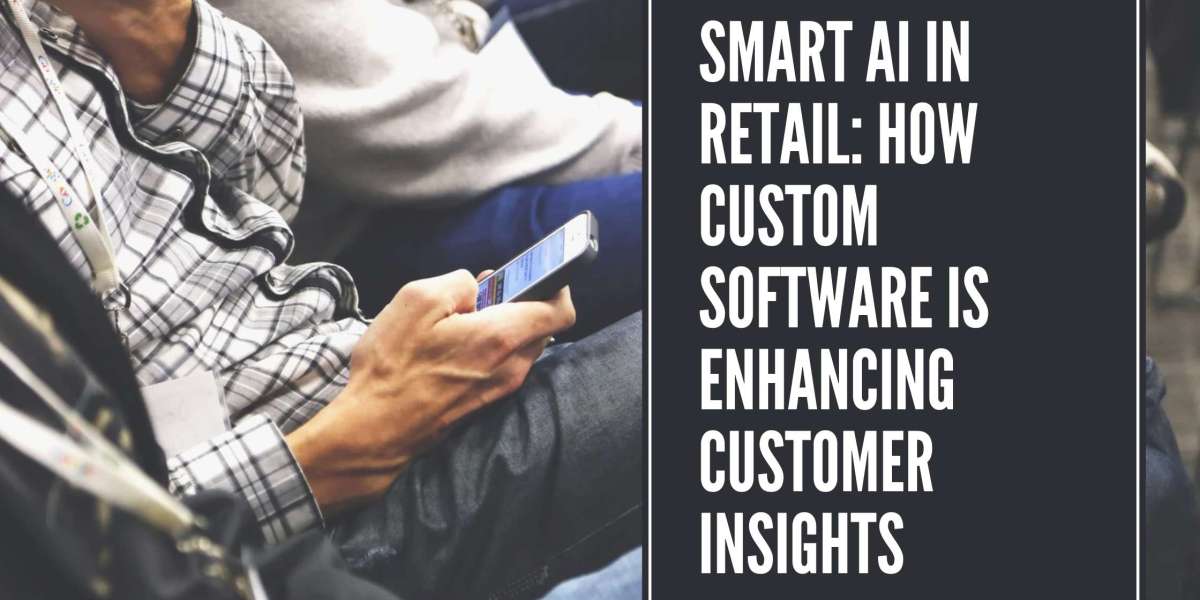The New Retail Revolution—And It’s Powered by Data
Retail has always been about understanding the customer. But in an age where people expect everything from same-day delivery to personalized recommendations, the bar for "understanding" has been raised sky-high. Enter Artificial Intelligence—and not the kind that just crunches numbers behind the scenes. We’re talking about smart AI integrated directly into retail operations through custom-built software, designed to deliver real-time, actionable insights about customer behavior.
This isn't some theoretical future. It’s happening now. From fashion chains to grocery stores, brands are investing in tailored AI solutions that do far more than analyze purchase history. These systems predict buying intent, adjust pricing dynamically, and optimize every touchpoint in the customer journey.
Let’s be honest—retailers no longer have the luxury of “gut feeling.” Precision is the name of the game, and AI is bringing the playbook.
How Retailers Are Leveraging AI—The Smart Way
You might’ve heard this before: “Retail is evolving.” Sure, but here’s the twist—retail is evolving intelligently. AI is no longer just about automation; it’s about augmentation. It augments decision-making. It enhances understanding. And most importantly, it enriches the customer experience.
Let’s break down some of the smart applications that are making waves:
Predictive Analytics: Knowing what your customer wants before they do might sound like science fiction, but predictive models based on AI are getting frighteningly good at this. Using custom software that pulls in real-time customer behavior, location, inventory data, and historical trends, retailers can now tailor promotions and optimize inventory decisions with pinpoint accuracy.
Sentiment Analysis: AI doesn’t just scan data—it reads emotions. Natural Language Processing (NLP) tools integrated into retail software can analyze reviews, chat transcripts, and social media mentions to give retailers a real-time pulse on how customers feel about products, services, or even a store layout.
AI-Powered Personalization Engines: Think beyond “Customers who bought this also bought that.” Today’s custom recommendation engines adapt in real-time based on browsing speed, session time, purchase history, and even weather. This level of personalized engagement is only achievable through deeply integrated, AI-powered platforms.
Visual Recognition and AI Cameras: Smart store cameras don’t just deter theft anymore. They track movement patterns, monitor dwell time at shelves, and even analyze facial expressions to decode customer preferences. This visual data feeds into custom analytics dashboards, giving retailers a new dimension of behavioral insight.
Beyond the Hype: Why Off-the-Shelf Tools Fall Short
Here’s the part most retailers overlook—AI isn’t plug-and-play. Sure, there are plenty of out-of-the-box AI tools floating around, but they’re usually generic, limited, and not designed for your business model. A large chain selling athletic wear operates differently from a boutique bakery, right? Their data needs, customer interactions, and operational goals are not the same.
Custom software built with AI at its core is different. It’s crafted specifically to meet the needs of the individual business, whether that’s integrating with a unique supply chain, syncing with legacy systems, or training machine learning models on proprietary customer behavior patterns.
Think of it this way: Would you wear someone else’s prescription glasses just because they’re trendy? Probably not. Why, then, rely on someone else’s AI setup to interpret your data?
What Real-Time Customer Insights Actually Look Like
The phrase “customer insights” gets thrown around a lot—but what does it actually mean when AI is in charge?
Dynamic Pricing Based on Micro-Trends: AI can detect sudden spikes in demand—sometimes tied to events, sometimes to unpredictable behavior patterns—and adjust pricing in real time. Imagine running a flash sale precisely when your audience is most engaged, without lifting a finger.
Churn Prediction Alerts: Through machine learning, AI-driven platforms can flag customers at risk of churn before it happens. Is a regular shopper suddenly engaging less? Are they browsing but not buying? These signals help you act before losing them to a competitor.
Emotionally Intelligent Chatbots: Today’s AI chatbots are far from robotic. They learn from each interaction, adapt their tone, and often escalate complex issues with appropriate timing. This creates a customer experience that’s not just efficient—but also empathetic.
In-Store Behavior Mapping: For brick-and-mortar retailers, foot traffic still matters. AI-enhanced heat maps generated from in-store sensors reveal which sections attract the most attention, what customers skip, and how layout changes influence buying.
From Insight to Action: The Real ROI of Smart AI
Data for data’s sake doesn’t move the needle. Insight is only valuable when it drives action—and here’s where custom software really flexes its muscle.
Smart AI doesn’t just report; it recommends. Better still, it often automates the best decision. Take inventory planning, for example. AI algorithms can anticipate stockouts before they happen and trigger automated reorder suggestions. No more guesswork, no more empty shelves. That’s operational efficiency in motion.
Or consider customer segmentation. Instead of segmenting based on simple demographics, AI analyzes behavior and intent, creating micro-segments like “price-sensitive evening browsers” or “weekend impulse buyers.” Your marketing team now knows exactly who to talk to and when.
The real value? Time saved, money better spent, and customers who feel truly understood.
The Tech Behind It: What Powers Smart AI in Retail?
Let’s peel back the curtain for a moment. What goes into building these smart, responsive systems?
Custom Data Pipelines: To feed AI, you need clean, structured data—and lots of it. Custom software development ensures your systems can ingest data from in-store sensors, eCommerce platforms, CRMs, ERPs, and even social media channels.
Machine Learning Models: These are trained on your historical data to learn patterns and make predictions. The more contextual and business-specific the model, the smarter the AI.
Real-Time Analytics Engines: Dashboards that used to update nightly now refresh by the second. That means you’re not reacting to yesterday’s problems—you’re preventing tomorrow’s.
Secure APIs and Integrations: Retail AI is only useful when it works seamlessly with existing systems—be it your POS software or your supplier’s database. That level of integration requires custom-built logic and airtight data security protocols.
Scalable Cloud Infrastructure: AI workloads aren’t light. Retailers using AI at scale rely on cloud-based infrastructures that can process millions of data points without a hiccup.
The Ethical and Practical Challenges—And How Smart Custom Software Navigates Them
It would be irresponsible to paint AI in retail as a silver bullet without acknowledging the risks. Customer privacy, data security, algorithmic bias—these are real issues that deserve serious attention.
That’s where custom software again proves its worth. When you’re not beholden to a third-party vendor’s black-box AI, you can design solutions that are transparent, compliant, and tailored to your ethical standards.
For example:
Consent-Driven Data Collection: Custom-built systems can be configured to collect only the data your customers have explicitly agreed to share.
Bias Auditing Tools: AI models need monitoring, just like any other employee. Custom platforms can include audit tools to check for bias in recommendations or customer treatment.
Flexible Governance Rules: Regional privacy laws vary wildly. Custom software ensures your data handling practices remain compliant in every geography you operate in.
Ethical AI is smart AI—and the smartest retailers are taking this seriously.
What’s Next? Hyper-Personalization, Edge AI, and Omnichannel Intelligence
We’re already seeing the next generation of AI-driven retail platforms that extend well beyond store walls or even websites. Here’s a glimpse:
Edge AI for In-Store Experience: Processing data right at the source—in the store—means faster decisions. Think AI that adjusts digital signage in real time based on crowd mood.
Hyper-Personalization: Imagine an app that suggests not just what you want to buy, but how to style it, where to wear it, and even when you’ll next need it based on calendar events.
Unified Omnichannel Analytics: No more silos between online and offline. Smart software merges data across channels, giving retailers one panoramic view of the customer journey.
The direction is clear: AI in retail is not about replacing people. It’s about enhancing human decision-making with machine precision. It’s about making businesses more intuitive, and customers more loyal.
Conclusion: Where Insight Meets Innovation
If you’re in retail, it’s no longer a question of whether to invest in AI—but how. The smartest move? Partner with a team that understands how to build intelligent systems from the ground up. Not templates. Not guesswork. But custom, data-driven platforms built to align with your vision.
Custom software infused with AI is what turns messy customer data into strategy. It’s what transforms stores into insight engines. And it’s how modern retailers stay not just afloat—but ahead.
For retailers looking to lead the curve with innovation, investing in custom solutions isn't a luxury—it’s a strategy. And if you’re exploring high-impact software development services in California, there’s never been a better time to take the leap.



